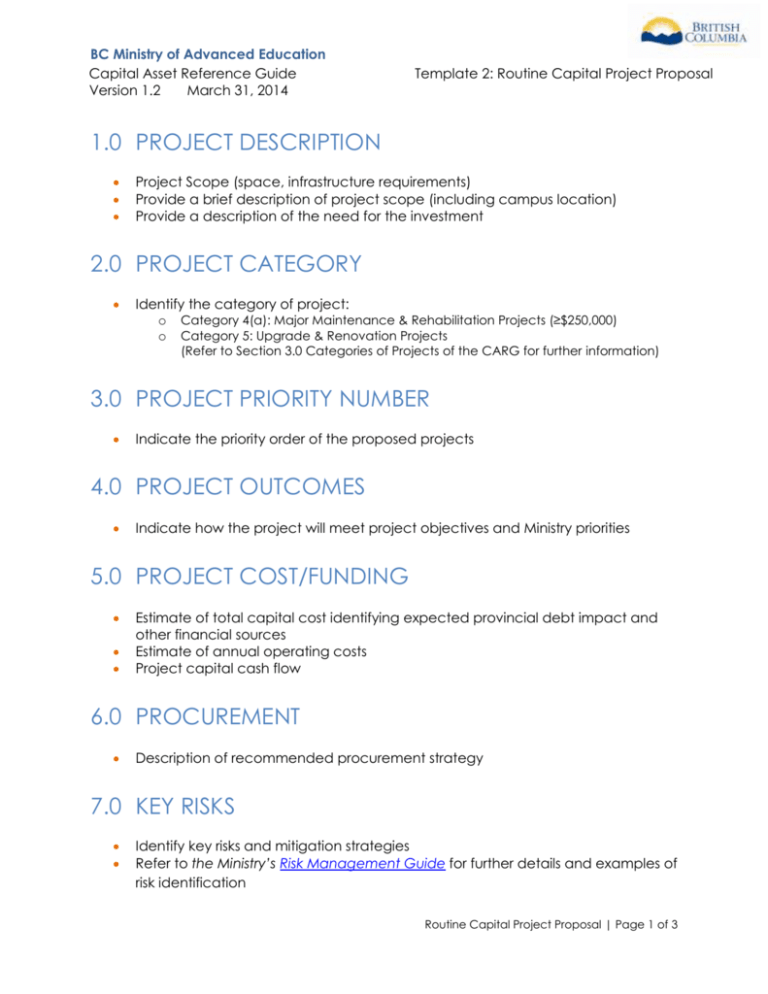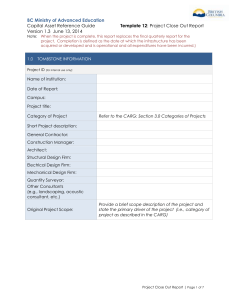Template 2 - Routine Capital Project Proposal
advertisement

BC Ministry of Advanced Education Capital Asset Reference Guide Version 1.2 March 31, 2014 Template 2: Routine Capital Project Proposal 1.0 PROJECT DESCRIPTION Project Scope (space, infrastructure requirements) Provide a brief description of project scope (including campus location) Provide a description of the need for the investment 2.0 PROJECT CATEGORY Identify the category of project: o Category 4(a): Major Maintenance & Rehabilitation Projects (≥$250,000) o Category 5: Upgrade & Renovation Projects (Refer to Section 3.0 Categories of Projects of the CARG for further information) 3.0 PROJECT PRIORITY NUMBER Indicate the priority order of the proposed projects 4.0 PROJECT OUTCOMES Indicate how the project will meet project objectives and Ministry priorities 5.0 PROJECT COST/FUNDING Estimate of total capital cost identifying expected provincial debt impact and other financial sources Estimate of annual operating costs Project capital cash flow 6.0 PROCUREMENT Description of recommended procurement strategy 7.0 KEY RISKS Identify key risks and mitigation strategies Refer to the Ministry’s Risk Management Guide for further details and examples of risk identification Routine Capital Project Proposal | Page 1 of 3 BC Ministry of Advanced Education Capital Asset Reference Guide Version 1.2 March 31, 2014 Template 2: Routine Capital Project Proposal 8.0 PROJECT SCHEDULE Indicate anticipated start/end dates including anticipated phases Include a simple Gantt chart with high level activities such as planning, design, construction, commissioning and occupancy Note: The Routine Capital Project Proposal will be evaluated based on the following: Infrastructure Improvements: Describe how and to what extent the project will improve FCI and/or reduce life safety & occupational health risks. Although the proposed project may not relate directly to learning outcomes, describe how it is critical to the Institution’s business continuity. Cost Effectiveness: Describe how and to what extent there are funding partnerships and/or cost benefits throughout the project lifecycle. Innovation: Describe how and to what extent it demonstrates sustainable solutions and/or demonstrates collaboration. Strategic Alignment: Describe how the project aligns with government priorities (e.g., Ministry Service Plan) and how the project aligns with institutional priorities? (e.g., mission statement, master planning, etc.). Quality Education: Describe how and to what extent the project will improve student learning outcomes, and/or improve access to learning and/or student full time equivalents (FTE) and space utilization rates Energy usage and GHG emissions: Describe how and to what extent the project will reduce energy usage and greenhouse gas emissions. Note: This summary should not exceed 2 pages Routine Capital Project Proposal | Page 2 of 3 BC Ministry of Advanced Education Capital Asset Reference Guide Version 1.2 March 31, 2014 Template 2: Routine Capital Project Proposal Routine Capital Project Proposal | Page 3 of 3









